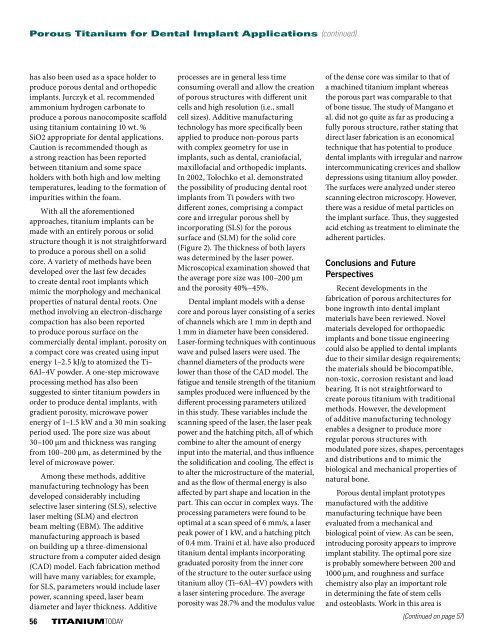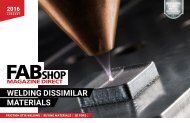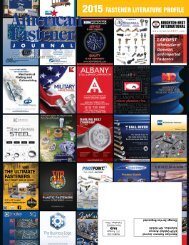100% Positive Material Identification
23mhiW2
23mhiW2
Create successful ePaper yourself
Turn your PDF publications into a flip-book with our unique Google optimized e-Paper software.
Porous Titanium for Dental Implant Applications (continued)<br />
has also been used as a space holder to<br />
produce porous dental and orthopedic<br />
implants. Jurczyk et al. recommended<br />
ammonium hydrogen carbonate to<br />
produce a porous nanocomposite scaffold<br />
using titanium containing 10 wt. %<br />
SiO2 appropriate for dental applications.<br />
Caution is recommended though as<br />
a strong reaction has been reported<br />
between titanium and some space<br />
holders with both high and low melting<br />
temperatures, leading to the formation of<br />
impurities within the foam.<br />
With all the aforementioned<br />
approaches, titanium implants can be<br />
made with an entirely porous or solid<br />
structure though it is not straightforward<br />
to produce a porous shell on a solid<br />
core. A variety of methods have been<br />
developed over the last few decades<br />
to create dental root implants which<br />
mimic the morphology and mechanical<br />
properties of natural dental roots. One<br />
method involving an electron-discharge<br />
compaction has also been reported<br />
to produce porous surface on the<br />
commercially dental implant, porosity on<br />
a compact core was created using input<br />
energy 1–2.5 kJ/g to atomized the Ti–<br />
6Al–4V powder. A one-step microwave<br />
processing method has also been<br />
suggested to sinter titanium powders in<br />
order to produce dental implants, with<br />
gradient porosity, microwave power<br />
energy of 1–1.5 kW and a 30 min soaking<br />
period used. The pore size was about<br />
30–100 µm and thickness was ranging<br />
from 100–200 µm, as determined by the<br />
level of microwave power.<br />
Among these methods, additive<br />
manufacturing technology has been<br />
developed considerably including<br />
selective laser sintering (SLS), selective<br />
laser melting (SLM) and electron<br />
beam melting (EBM). The additive<br />
manufacturing approach is based<br />
on building up a three-dimensional<br />
structure from a computer aided design<br />
(CAD) model. Each fabrication method<br />
will have many variables; for example,<br />
for SLS, parameters would include laser<br />
power, scanning speed, laser beam<br />
diameter and layer thickness. Additive<br />
56 TITANIUMTODAY<br />
processes are in general less time<br />
consuming overall and allow the creation<br />
of porous structures with different unit<br />
cells and high resolution (i.e., small<br />
cell sizes). Additive manufacturing<br />
technology has more specifically been<br />
applied to produce non-porous parts<br />
with complex geometry for use in<br />
implants, such as dental, craniofacial,<br />
maxillofacial and orthopedic implants.<br />
In 2002, Tolochko et al. demonstrated<br />
the possibility of producing dental root<br />
implants from Ti powders with two<br />
different zones, comprising a compact<br />
core and irregular porous shell by<br />
incorporating (SLS) for the porous<br />
surface and (SLM) for the solid core<br />
(Figure 2). The thickness of both layers<br />
was determined by the laser power.<br />
Microscopical examination showed that<br />
the average pore size was 100–200 µm<br />
and the porosity 40%–45%.<br />
Dental implant models with a dense<br />
core and porous layer consisting of a series<br />
of channels which are 1 mm in depth and<br />
1 mm in diameter have been considered.<br />
Laser-forming techniques with continuous<br />
wave and pulsed lasers were used. The<br />
channel diameters of the products were<br />
lower than those of the CAD model. The<br />
fatigue and tensile strength of the titanium<br />
samples produced were influenced by the<br />
different processing parameters utilized<br />
in this study. These variables include the<br />
scanning speed of the laser, the laser peak<br />
power and the hatching pitch, all of which<br />
combine to alter the amount of energy<br />
input into the material, and thus influence<br />
the solidification and cooling. The effect is<br />
to alter the microstructure of the material,<br />
and as the flow of thermal energy is also<br />
affected by part shape and location in the<br />
part. This can occur in complex ways. The<br />
processing parameters were found to be<br />
optimal at a scan speed of 6 mm/s, a laser<br />
peak power of 1 kW, and a hatching pitch<br />
of 0.4 mm. Traini et al. have also produced<br />
titanium dental implants incorporating<br />
graduated porosity from the inner core<br />
of the structure to the outer surface using<br />
titanium alloy (Ti–6Al–4V) powders with<br />
a laser sintering procedure. The average<br />
porosity was 28.7% and the modulus value<br />
of the dense core was similar to that of<br />
a machined titanium implant whereas<br />
the porous part was comparable to that<br />
of bone tissue. The study of Mangano et<br />
al. did not go quite as far as producing a<br />
fully porous structure, rather stating that<br />
direct laser fabrication is an economical<br />
technique that has potential to produce<br />
dental implants with irregular and narrow<br />
intercommunicating crevices and shallow<br />
depressions using titanium alloy powder.<br />
The surfaces were analyzed under stereo<br />
scanning electron microscopy. However,<br />
there was a residue of metal particles on<br />
the implant surface. Thus, they suggested<br />
acid etching as treatment to eliminate the<br />
adherent particles.<br />
Conclusions and Future<br />
Perspectives<br />
Recent developments in the<br />
fabrication of porous architectures for<br />
bone ingrowth into dental implant<br />
materials have been reviewed. Novel<br />
materials developed for orthopaedic<br />
implants and bone tissue engineering<br />
could also be applied to dental implants<br />
due to their similar design requirements;<br />
the materials should be biocompatible,<br />
non-toxic, corrosion resistant and load<br />
bearing. It is not straightforward to<br />
create porous titanium with traditional<br />
methods. However, the development<br />
of additive manufacturing technology<br />
enables a designer to produce more<br />
regular porous structures with<br />
modulated pore sizes, shapes, percentages<br />
and distributions and to mimic the<br />
biological and mechanical properties of<br />
natural bone.<br />
Porous dental implant prototypes<br />
manufactured with the additive<br />
manufacturing technique have been<br />
evaluated from a mechanical and<br />
biological point of view. As can be seen,<br />
introducing porosity appears to improve<br />
implant stability. The optimal pore size<br />
is probably somewhere between 200 and<br />
1000 µm, and roughness and surface<br />
chemistry also play an important role<br />
in determining the fate of stem cells<br />
and osteoblasts. Work in this area is<br />
(Continued on page 57)







